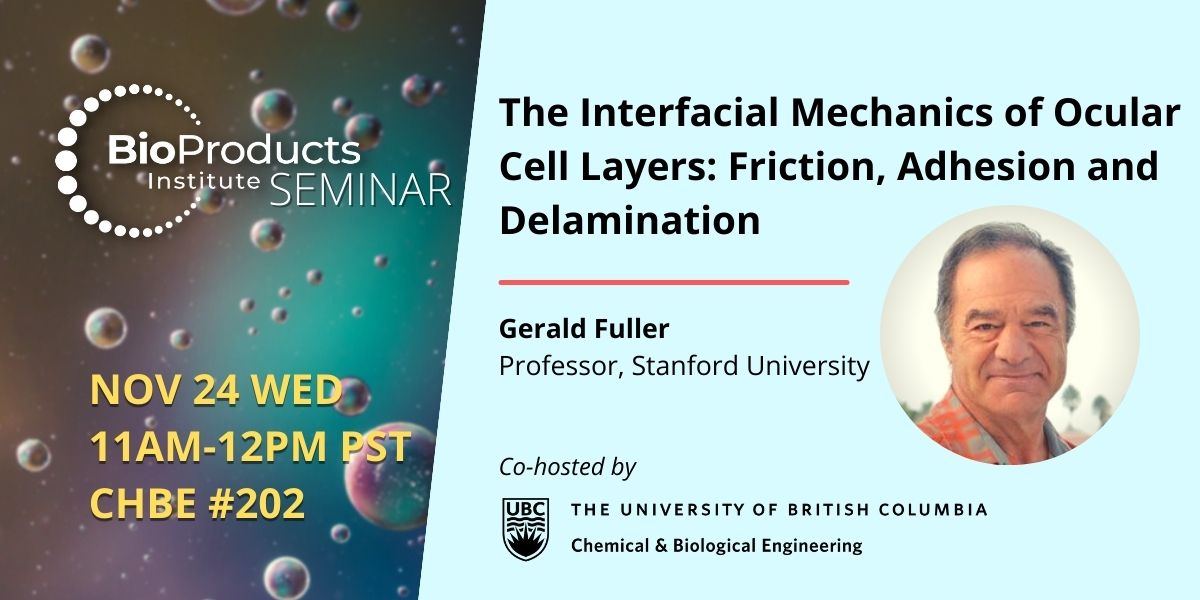BPI SEMINAR BY DR. GERALD FULLER
November 24, 2021, 12:00 am to 12:00 am
TITLE
The Interfacial Mechanics of Ocular Cell Layers: Friction, Adhesion and Delamination
DATE & TIME
November 24th Wednesday 11AM-12PM PST
LOCATION
CHBE Room 202, 2360 East Mall, Vancouver, BC V6T 1Z3 (Sorry no Zoom link, In-person Only)
ABOUT THE EVENT
Join us to learn about the mechanics of the eye at a cellular level! This presentation will describe two experimental platforms designed to interrogate the interaction of layers of ocular cells with one another, as in the case of the sliding friction of corneal epithelial cells across conjunctival cells, and the direct interaction of ocular cell layers with air.
This seminar is co-hosted by CHBE (Department of Chemical & Biological Engineering, UBC). Refreshments will be provided.
ABOUT THE SPEAKER
Gerald Fuller is the Fletcher Jones Professor of Chemical Engineering at Stanford University. He joined Stanford in 1980 following his graduate work at Caltech where he acquired his MS and PhD degrees. His undergraduate education was obtained at the University of Calgary, Canada. Professor Fuller's interests lie in studies of rheology and interfacial fluid mechanics. His work has been recognized by receipt of the Bingham Medal of The Society of Rheology, membership in the National Academy of Engineering, election to the American Academy of Arts and Science, and honorary doctorates from the Universities of Crete, Greece, and Leuven, Belgium. He presently serves as the General Secretary to the International Committee on Rheology.
ABSTRACT
The ocular surface is comprised of stratified layers of cells: corneal epithelial cells and conjunctival cells. These layers are subject to sliding friction during the course of a blink cycle and are protected by the tear film. This aqueous liquid film is enriched with endogenously expressed mucins, which are known to contribute to its lubricious character. Maintaining the stability of this film is essential to ocular health since it helps to eliminate foreign matter and regulates optical acuity. Maintenance of a stable tear film requires a delicate balance of its constituents and when this does not occur, the film can break, leading to conditions referred to as dry eye disease (DED). This presentation describes two experimental platforms designed to interrogate the interaction of layers of ocular cells with one another, as in the case of the sliding friction of corneal epithelial cells across conjunctival cells, and the direct interaction of ocular cell layers with air.
The first set of experiments investigates the problem of mucin deficiency where reduced biosynthesis or loss of functional mucins has been reported in some DED patients. Here we developed a mucin-deficient dry eye mimetic cell model to investigate the contributions of mucins and mucin-like glycoproteins to the interfacial, rheological, and adhesive properties of ocular epithelial surfaces. Cell-to-cell adhesion and sliding friction were directly measured using a newly developed Live Cell Rheometer (LCR). It is demonstrated that membrane-tethered mucins are essential for biolubrication. Supplementation with recombinant human lubricin, a mucin-like glycoprotein, restored the lubrication function induced by the lack of cell surface mucins in a dose-dependent manner.
The second set of experiments examined the direct interaction of air bubbles against stratified ocular cell layers. Here, small bubbles were released below cell layers that were oriented face-down. Tilting of the surface layer introduced a simple gravitational force onto the bubble, causing it to tug on the cell layer with fore-and-aft advancing and receding contact angles. Remarkably, the cell layers, which were adherent to the bubbles, delaminated from the substrates onto which they were attached (collagen-coated glass). This simple experiment allows one to directly measure the surface energies of the cell layers, the tensile strength of the layers, and the force of adhesion of the layers onto various substrates.
